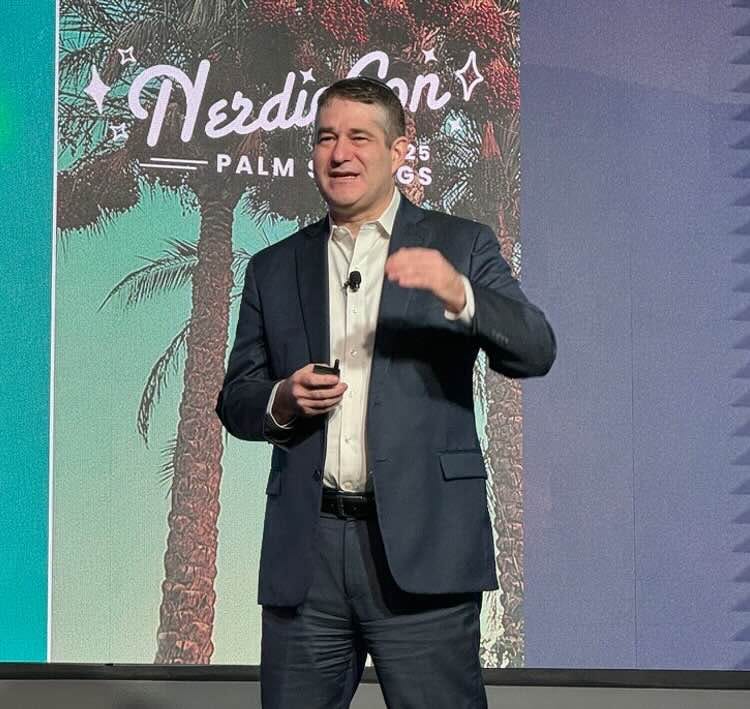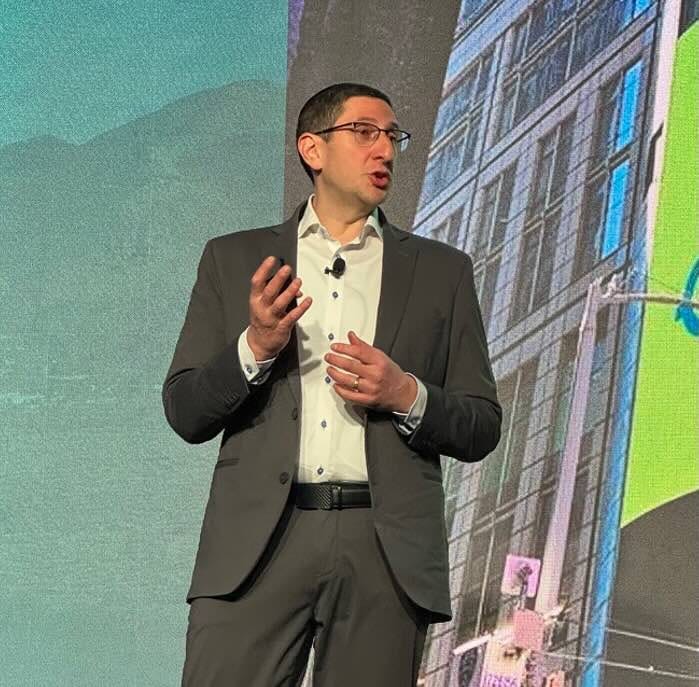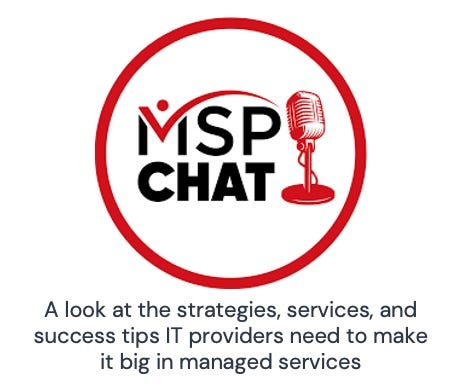Nerdio’s Not-So-Secret Success Formula
Product discipline and obsessive attention to customers, the company says, are what landed it in unicorn territory. Plus: Shadow AI data from Auvik and recession advice from ConnectWise and Kaseya.
Why aren’t we all talking about Nerdio more?
I mean, I understand why Google’s Cloud Next event got a lot more attention than the NerdioCon show I attended this week given Google’s outsized influence on our industry.
And I totally endorse the attention paid to N-able’s Empower event, which ran parallel to NerdioCon in Berlin. N-able’s one of the biggest names in MSP software and services, and it made multiple product announcements during the show (all of which, as regular Channelholic readers no doubt anticipated, were resilience-related).
I’m personally responsible for additional coverage dedicated in recent weeks to other leading names in managed services software, including NinjaOne, which has been valued at an impressive $5 billion since February.
Yet Nerdio’s valuation is pretty high too, somewhere above $1 billion in fact following the $500 million Series C funding round the company announced last month. That’s 4x where it was valued just two years ago, and other important numbers are rising fast as well. ARR, for example, is up 100% in the last year and partner count is up more than 120% in the same time span.
There are now, in fact, some 3,000 MSPs and IT departments in over 50 countries using Nerdio software to manage Azure Virtual Desktop, Windows 365, Microsoft 365, and other elements of the Microsoft cloud. A non-trivial portion of those organizations were represented in person at NerdioCon to soak up the vendor’s latest product news (an updated edition of Nerdio Manager for Enterprise) and enablement plans.
A lot of startup founders read Channelholic (thanks, startup founders!). Nerdio’s story, I’d argue, has useful lessons for them even if nothing they do touches SaaS productivity, virtual desktops, or MSPs.
1. Focus, focus, focus. There’s a lot going on in the cloud. Nerdio credits much of its success to building everything it makes for one class of user (IT professionals) and one critical function (end-user computing).
“We do not let ourselves get distracted by requests that are not related to the EUC domain,” says Amol Dalvi, the company’s vice president of product.
Or not related to Microsoft’s cloud, adds Joseph Landes (pictured), Nerdio’s co-founder and CRO. “100% of MSPs in the world are involved in the Microsoft cloud in some way, shape, or form,” he says. “We chose one option and we’re going super deep.”
That, along with the $350 million a year in Azure spending Nerdio presently influences, explains the company’s unusually close working relationship with Microsoft, not to mention the in-person speaking appearances this week by both Nina Harding, the tech giant’s corporate vice president of global partner solutions for the Americas, and Scott Manchester, vice president of Windows 365 and Azure Virtual Desktop.
2. You really can’t be too obsessed with product-market fit. And especially with the “market” part of that equation, as in your customers. Ask Vadim Vladimirskiy, Nerdio’s CEO and other co-founder, about the secret to Nerdio’s success as I did two days ago, in fact, and he’ll tell you it’s not much of a secret.
“It’s being an outside-in company,” he says. “Figuring out what customers’ real-world problems are and solving those problems as quickly as possible.”
Indeed, according to Dalvi, everything about Nerdio Manager for Enterprise and Nerdio Manager for MSP reflects that dedication to giving users what they want and need.
“It’s not just lip service,” he says. Nerdio bases every potential addition to its roadmap on feature requests from customers, and decides which ones to pursue based on feedback from five (soon to be six) advisory boards, each of which meets at least five times a year. Advisory board members, moreover, base their thumbs-up-or-down votes on mockups of proposed enhancements that help them see how new functionality would work.
“We don’t just stand up in a conference room and talk at them,” Dalvi explains, noting that the company gets better feedback leading to better features and fewer flops as a result.
“It definitely increases the success rate,” he says, as does the fact that the people casting ballots are all “hands on keyboard” users who live in Nerdio Manager all day, rather than the decision-making budget owners who pay for the software.
3. Good timing never hurts. Nerdio bet big on Microsoft’s cloud business early enough to capitalize on years of double-digit growth, including the 21% year-over-year revenue spike—to $40.9 billion—recorded in the company’s most recently completed quarter. More recent frustration among VMware and Citrix partners with parent companies Broadcom and CSG, respectively, over a variety of perceived and very real slights has been helpful as well.
“Citrix has been a tremendous tailwind to our business,” Landes says. “I don’t think we’ve run into a Citrix customer who wants to stay.”
4. Don’t mess with success. Which for Nerdio, according to Vladimirskiy, has meant “staying humble, listening, learning, and just kind of doing that repeatedly.”
Where the money’s going
If my back of the envelope math checks out, General Atlantic and the other participants in the $500 million funding round that valued Nerdio at approximately $1 billion now own approximately half the company. Which would be bad news for anyone inherently suspicious of private equity firms except that General Atlantic, according to Vladimirskiy (pictured), isn’t a private equity firm.
“The companies that we’ve been talking to and the companies that ultimately became the backers in this round are growth equity companies,” he says. Private equity investors optimize for EBITDA in ways that can slow down R&D and limit support, he continues. Growth equity investors, by contrast, optimize for revenue in ways that accelerate past successes and help identify new ones.
For Nerdio, that means continued expansion into overseas markets (including the United Arab Emirates, where Nerdio will soon open its first subsidiary) and a lot more product development.
“We have very ambitious plans for the rest of the year,” Vladimirskiy told NerdioCon attendees during a Tuesday keynote.
“We’ll have a new capability called the AI Policy Butler, which is going to help you take care of policy housekeeping tasks,” he said. “We’re going to have advanced reporting capabilities that will allow you to create customizable dashboards and reports to gain deep visibility into the various components of Microsoft 365 and Intune, and finally, we’ll have new workflows that will help you automate on and offboarding of your users.”
Look for Nerdio to add support for additional Microsoft technologies as well in response to outside-in feedback. “[Microsoft] Purview for governance keeps coming up a lot,” Dalvi says. “I’ve had several conversations just at this conference where MSPs have brought that up.”
Two new senior product directors, one promoted from within this month and another joining the company next month, will oversee efforts like that and others unspecified to come.
“The more components that can be managed through our platform, the better,” Vladimirskiy says.
And make no mistake, he adds. Nerdio may not have the soup-to-nuts ambitions of a Kaseya but it absolutely is a platform company, one with few direct competitors and a massive TAM.
“We sort of have this unique approach to being able to manage many technologies that Microsoft cloud customers of MSPs are using,” Vladimirskiy says. “The more technologies there are and the more other solutions that can be eliminated from the tech stack of MSPs, I think, the more successful and the more sticky Nerdio will be.”
Will shadow AI make SaaS management mainstream?
There’s a reason Nerdio went deep in the Microsoft cloud. It’s the same reason N-able’s new breach prevention product targets Microsoft 365 and why so many cloud-to-cloud backup products support Microsoft 365, maybe Google Workspace, and not much else.
A lot of businesses run Microsoft 365. Microsoft was north of 400 million paid Office 365 seats a year ago, and is presumably pushing half a billion by now. Supporting all those users is easily the biggest SaaS-related revenue opportunity for MSPs today.
And yet not the only one. I’m writing this post on a Microsoft 365 app, but have Trello, Notion, Zoom, and a couple of different Zoho solutions purring quietly in the background as I do so. You’re undoubtedly in and out of Slack, Salesforce, HubSpot, and other non-Microsoft SaaS apps all day too.
If you’re an MSP, your customers are using those and similar systems as well. The only question is whether they—or you—know about it. Shadow IT has been a problem in technology for a long time, but it’s become endemic in the age of SaaS and smartphones.
And extra endemic, it seems, in the age of AI. Half of employees surveyed by Software AG last year admitted to using unauthorized, bring-your-own-AI at work.
Aggregated, anonymized data shared with me by network and SaaS management vendor Auvik this week makes the phenomenon a little easier to see. I don’t know how much of the time people spend in DeepSeek at work is authorized at present, but I can safely say none of it was late in January when the world first encountered the Chinese genAI service. And yet just in that initial headline-grabbing week, there was a lot of DeepSeek traffic crossing corporate networks.
There’s a lot of ChatGPT traffic flowing around businesses these days too. The OpenAI service jumped from 28th place to 13th in Auvik’s active SaaS usage rankings just between January and March this year.
“That means it’s more used than something like an Atlassian, a Smartsheet, an Amazon Web Services,” notes John Harden, Auvik’s director of strategy and technology evangelism. “I don’t know if I can find an entire environment at this point that doesn’t have AI somewhere amongst the ranks of tools being used.”
A lot of those tools dwell in the shadows, moreover, a disturbing fact with like-it-or-not implications for MSPs.
“This is a place where MSPs are going to have to focus,” Harden (pictured) says. “Customers are shifting their workload into using AI, and they really don’t have visibility into it.”
Which means they don’t know how often data leakage and compliance violations, among other issues, are occurring either. Harden sees a silver lining in that for Auvik and other makers of SaaS management software for MSPs.
“For years and years and years, we’ve been pushing down this story,” he says. “SaaS management is going to be a table stake of the industry.” AI could be the issue that brings that prediction to life.
“This might be the water that breaks the dam for MSPs to say, ‘it really matters what SaaS is in our customers’ landscape. We really have to get this thing under control.’”
Which they can’t do, Harden maintains, using RMM software alone. “The core thing that RMMs tell you is what software’s being used and installed on the device,” he says. “SaaS management platforms tell you what is being used in the browser and in the cloud.”
Some of which might be ferrying data to China.
Early days in navigating tariffs
The other thing most SaaS management platforms can tell an MSP is what their clients are spending in the cloud. It’s typically not a pretty picture at first.
“25% of SaaS licenses are waste,” Harden says, mostly due to overprovisioning and dormant accounts that should have been deactivated but never were. Finding and eliminating that waste is a service customers appreciate.
“It puts money back in their pockets,” Harden says.
That’s always in fashion, of course, but may prove even more popular soon. Because nine days after the Trump administration first announced them and two days after it suspended them for 90 days, there’s still much we don’t know about what tariffs are going to mean for the economy generally and the IT industry specifically.
HP, for one, is unfazed. Just weeks after bending over backwards to assure partners it can handle whatever the White House has in store, the company remains confident it’s ready for anything, per a statement supplied to Channelholic:
“Our strong relationships with supply chain partners around the world allow us to remain agile and responsive to changes, as we are not tied primarily to company-owned infrastructure or factories in countries heavily impacted by tariffs. We will continue to monitor developments and have the ability to adjust operations as needed.
Personally, I’d argue that some of the nations in HP’s globally diversified supply chain will be heavily impacted if the tariffs announced last week go into effect three months from now. Thailand’s rate, for example, would rise to 36%, while Indonesia’s would climb to 32%. Not quite the 145% China’s paying at the moment, but still.
Even at today’s 10%, though, tariffs are likely to drive hardware prices up. Both IDC and Canalys, in fact, warned this week of volatility ahead in PC shipments for that very reason despite a reasonably strong Q1 and Windows 10’s ever approaching EOL.
Meanwhile, what looks to be a blow to hardware makers could end up being a boon to Microsoft and Nerdio. According to a recently published study performed by Forrester on behalf of Microsoft, 58% of organizations with experience deploying Windows 365 saved $1,000 or more per user by issuing virtual rather than physical desktops. If word gets around about numbers like that, businesses nervous about hardware spending might start buying more Cloud PCs, leading MSPs and IT departments to buy more Nerdio software for managing those Cloud PCs.
“There’s an argument to be made that any technology solution that is not hardware heavy maybe benefits from this,” says Vladimirskiy of tariffs. “But who knows? Things are changing on an hourly basis. It’s hard for us to predict.”
I’d go a step further and say it’s impossible to predict market trends right now for everyone, very much including MSPs, many of whom don’t have the kind of cash cushion Nerdio, Microsoft, and HP can tap into if we find ourselves in a recession.
ConnectWise, as it happens, shared timely recommendations on preparing for “the next emergency” in a recent newsletter commemorating the last one, the Covid pandemic that began five years ago. Peter Kujawa, the vendor’s executive vice president of Service Leadership and IT Nation, has further thoughts of his own.
“If ‘the next emergency’ does hit,” he writes in emailed remarks, “MSPs will first feel the impacts with delayed or cancelled projects from their clients. That will be felt in the first 1-2 quarters. Managed service declines will be slower but if you are tracking the number of users you are supporting, you’ll see the declines and within 3 quarters, you’ll likely be down 10-15, maybe 20% in a true, 2008 style, recession. As MSPs see their projects and user counts trail off, they should be adjusting staffing accordingly, ideally through attrition and adjusting hiring plans.”
For his part, Gary Pica, founder of MSP consultancy (and Kaseya unit) TruMethods, plans to suggest the following during a peer group meeting next week:
Take command over the business. This means dialing in operations and finance. Conserving resources, reducing waste, defending revenue. Be prepared for non-recurring revenue like projects to freeze. Find ways of pulling work forward by doing work now and billing over time in order to keep resources billable.
Overcommunicate with customers, employees, and vendors.
Stay on top of AR and establish a line of credit.
When customers ask for concessions, use it as a way to extend agreements. Lower price in the short term and get it back over the life of the agreement.
Focus on sales. As competitors falter you can gain new logo sales.
This is all based on experience gleaned from past downturns, notes Pica, who was a pioneer-generation MSP years ago. Here’s hoping today’s MSPs don’t end up needing his hard-earned wisdom.
Anxious about the future?
Why not unwind with a good podcast? The one I co-host features marketing communications advice for MSPs from Xavier Gonzalez, Kaseya’s chief communications officer, plus a hint or two about the big product news coming in a few weeks at the Kaseya Connect conference in Las Vegas. Tune in here:
Also worth noting
A brand new AI model, new agentic AI functionality, and a new Unified Security offering are among the many, many rollouts showcased at Google Cloud Next this week.
CrowdStrike, Infoblox, and Rubrik are among many Google partners that broke news during Cloud Next.
As we told you earlier in this week’s post, N-able is offering breach prevention protection for Microsoft 365 and (per recent reporting here) has vulnerability management functionality coming soon.
CyberFOX and Syncro have inked a strategic alliance pact.
Fortinet has added yet more AI functionality to its Security Fabric platform.
A new AI Machine Identity Discovery capability is but one of many updates to SailPoint’s Identity Security Cloud.
CyberArk has new machine identity security functionality too.
DNSFilter has acquired fellow filtering vendor Zorus. Former ConnectWise exec Brett Cheloff will serve the combined companies as chief product officer.
Radiant Security has unveiled what it calls the first adaptive AI SOC platform.
NinjaOne’s endpoint management platform now integrates with Zendesk.
A new AI-powered feature in Intermedia’s Intelligent Contact Center solution feeds real-time insights and automation to call center agents.
Evergreen Services Group, who you read about here recently, plans to roll the Acumatica ERP practice it just bought from High Touch Technologies into its i-Tech Support unit.
Tariffs or no tariffs, Dell has a bunch of new servers and storage arrays.
Support for virtual private clouds is among multiple updates from Hewlett Packard Enterprise to its Aruba Networking Central solution.
Craig Foster is the new CFO at Pax8.








